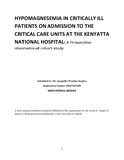| dc.description.abstract | Background: The prevalence of hypomagnesaemia in critically ill adult patients varies between
14-66%. Magnesium depletion is described as the most under diagnosed electrolyte abnormality
in current medical practice yet it plays a fundamental role in cell functions that include: energy
transfer, protein, carbohydrate and fat metabolism, maintenance of normal cell membrane
function and the regulation of parathyroid hormone secretion(PTH). Magnesium depletion has
been directly associated with hypokalemia, hypocalcemia, and arrthythmias. It’s also been
associated with worse clinical outcomes among the critically ill, hence hypomagnesaemia has
prognostic importance on patient’s outcome. There’s lack of local data on the prevalence of
hypomagnesaemia among the critically ill patients.
Objective: The aim of the study was to determine the prevalence of serum hypomagnesaemia in
critically ill patients on admission to the Kenyatta National Hospital critical care units, to assess
related electrolyte abnormalities and to explore the role of hypomagnesaemia in outcome
prediction.
Study design: Prospective observational cohort study.
Study site: Kenyatta National Hospital’s critical care units.
Study Population: Critically ill patients on admission to the critical care units at Kenyatta
National Hospital.
Methodology: Critically ill patients on admission to the critical care units (CCU) were screened
for eligibility and recruited upon signing an informed consent either by patient or proxy.
Patient’s demographics and clinical information were captured in a study proforma. Acute
Physiology And Chronic Health Evaluation II( APACHE II) score was determined and a 12 lead
ECG performed within 24 hrs of admission into the critical care units. Investigations done
included; serum magnesium, potassium, sodium, calcium and albumin levels, full hemogram,
serum creatinine and arterial blood gas analysis for which blood was drawn within 24 hours of
admission. Patients were thereafter followed up for 2 weeks outcome. Data analysis was done
using STATA version 11.
12
Results: Totally, 198 critically ill patients who were admitted to medical /surgical critical care
units were enrolled in this study during a 4month period. The mean age of patients was
42.8±18.9 yrs (range, 13-92 yrs). There were 138 males (69.7%) and 60 (30.3%) females. The
mean APACHE II score was 24.1±6.5.
The mean serum magnesium level measured during the first 24 hours of admission was
0.9±0.4Mmol/L (range, 0.4-4.5 Mmol/L). On admission, 137 patients (69.2%) had normal serum
magnesium level, while 33 patients (16.7%) had hypomagnesaemia and 28 patients had
hypermagnesaemia (14.1%).The mean serum calcium levels were 2.3±0.2Mmol/L (range,1.4-2.7
Mmol/L), 181 subjects (73.7%) had normal serum calcium levels, while 12 subjects (6.1%) had
hypocalcemia and 5 patients (2.5%) had hypercalcemia. The mean serum potassium levels were
4.7±1.2Mmol/L (range, 2.5-9.0 Mmol/L), 121 subjects (61.1%) had normal potassium levels ,
while 58 subjects (29.3%) and hyperkalemia and 19 patients (9.6%) had hypokalemia.
The median length of CCU stay was 3days (IQR; 1.75-10.75 days). Mechanical ventilation was
applied for 36.8% (n=73) of patients. The length of mechanical ventilation for those attached to
the ventilator was 48hrs (IQR; 24-108 hrs). The mortality rate at 14 days was 55.1% (n=109).
A higher APACHE II score was observed more frequently in the patients who had low
magnesium compared to the normal magnesemic patients (26.5±7.6 Vs 23.7±6.1 p= 0.03). A
longer QTc interval was also observed more frequently in the hypomagnesemic patients
compared to the normal magnesemic patients (434.8±39.9 Vs 408.8 ± 29.8 p< 0.001). There was
no association between serum magnesium levels and clinical outcomes.
Conclusion: This study found that the prevalence of hypomagnesaemia is common in the critical
care setting and more so in the very severely ill patients. Therefore, routine monitoring of serum
magnesium and clinical assessment of patients at risk for magnesium deficiency remains vital for
making a timely diagnosis of magnesium depletion. | en |
| dc.description.department | a
Department of Psychiatry, University of Nairobi, ; bDepartment of Mental Health, School of Medicine,
Moi University, Eldoret, Kenya | |

